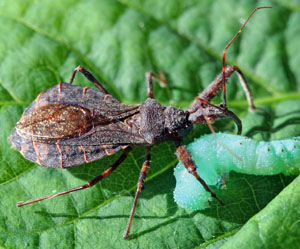
There are more than 160 species in the family Reduviidae (the assassin bugs, ambush bugs, and thread-legged bugs) in North America, many of which are fairly common. Most assassin bugs are medium-sized to large predators of crop pests, but the family does contain a few blood-sucking species. Even the beneficial insect predators can inflict a painful bite if handled carelessly, resulting in localized inflammation.
Adult assassin bugs are often usually 1/2 to 3/4″ long. Many species are brownish or blackish, but some species are brightly colored. The elongated head is narrow with a distinct “neck” behind the often reddish eyes. The long, curved mouth parts form a stout beak which is carried beneath the body, with the tip fitting in a groove on the underside of the body. The middle of the abdomen is often widened, so the wings don’t completely cover the width of the body. The female lays eggs in tight, upright clusters on leaves or in the soil. Nymphs (juveniles) resemble miniature, wingless adults.
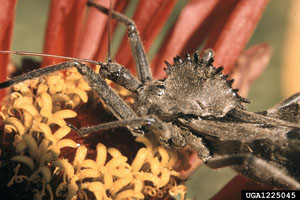
Most assassin bugs are generalist predators in gardens and fields. They sit in wait of prey and are most likely to attack small flying insects, however they can subdue and kill medium-sized caterpillars and similar insects. Some prey in vegetable plantings include aphids, leafhoppers and asparagus beetle eggs and larvae. They may feed on beneficial species as well as pests. Although they have not been specifically manipulated for biological control, they do contribute to natural control and their conservation by judicious pesticide use is beneficial. The wheel bug, Arilus cristatus, is one of the largest and most easily recognized assassin bugs. The adult is about 1 1/4″ long, gray in color, and has a striking semicircular crest on the upper back that looks like a cogwheel. Females are much larger than the males. This species is an important predator of forest insects. Wheel bugs feed on aphids as young nymphs. Later they attack caterpillars such as the fall webworm and other pests such as the locust borer. This species is common to the south and east of Wisconsin.
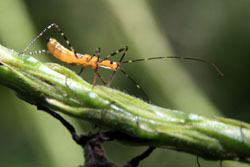
There are several other species of assassin bug that feed on forest insects including pine webworm, gypsy moth, and May beetles. Another commonly-encountered assassin bug is the masked hunter, or “masked bedbud hunter” (Reduvius personatus). This brownish-black bug is often found in houses, where it feeds on bed bugs. The soft-bodied nymphs cover themselves with dust, earning the name “dust bugs.”
Ambush bugs are smaller (1/2″ or less), stout-bodied insects with thickened, praying mantid-like (raptorial) front legs. Although they are small they can capture much larger insects, such as bumble bees. They lie in wait for their prey on flowers. They are found on many fall-blooming yellow or yellow and white flowers, where their greenish-yellow color allows them to be well camouflaged. Their prey is mostly large bees, wasps and flies, so they do not contribute much to insect pest control in plantings.

– Susan Mahr, University of Wisconsin – Madison
February, 2025





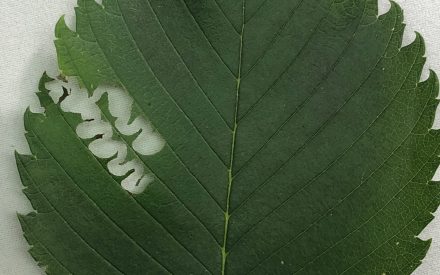 Elm Zigzag Sawfly
Elm Zigzag Sawfly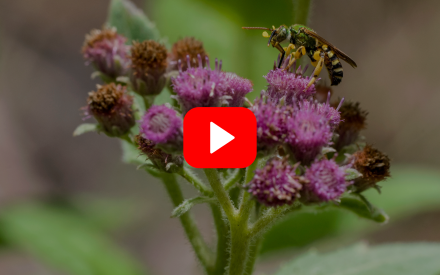 ▶ Watch: Pollinator Gardens: Plant Selection and Garden Care
▶ Watch: Pollinator Gardens: Plant Selection and Garden Care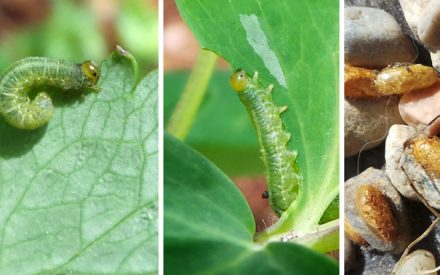 Strategies for Identifying and Managing Insect Pests
Strategies for Identifying and Managing Insect Pests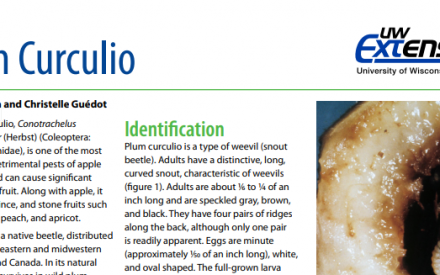 Plum Curculio
Plum Curculio


